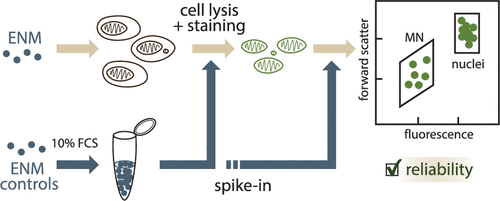当前位置:
X-MOL 学术
›
Chem. Res. Toxicol.
›
论文详情
Our official English website, www.x-mol.net, welcomes your
feedback! (Note: you will need to create a separate account there.)
Exploring flow cytometry-based micronucleus scoring for reliable nanomaterial genotoxicity assessment.
Chemical Research in Toxicology ( IF 3.7 ) Pub Date : 2020-09-18 , DOI: 10.1021/acs.chemrestox.0c00071 Pauline Franz 1 , Alexander Bürkle 2 , Peter Wick 1 , Cordula Hirsch 1
Chemical Research in Toxicology ( IF 3.7 ) Pub Date : 2020-09-18 , DOI: 10.1021/acs.chemrestox.0c00071 Pauline Franz 1 , Alexander Bürkle 2 , Peter Wick 1 , Cordula Hirsch 1
Affiliation

|
The increased use of engineered nanomaterials (ENM) such as SiO2 and TiO2 in industrial products, especially in food, raises concerns with regard to their effect on human health. In particular, ENM-induced genotoxicity is crucial to investigate, since DNA damage can cause induction or promotion of carcinogenesis. However, current in vitro and in vivo nanogenotoxicological data are highly contradictory, which impedes interpretation and extrapolation. Hence, robust, reliable, and ideally scalable in vitro methods for nanogenotoxicity assessment are of great interest. This work aimed at evaluating the suitability of flow cytometry-based micronuclei scoring for reliable nanogenotoxicological assessment in human intestinal cells. Therefore, we have evaluated the genotoxicity of differently sized SiO2 and TiO2 from different sources (food-relevant, commercially available, and laboratory-synthesized) using the well-established alkaline single cell gel electrophoresis (Comet assay) and the micronucleus (MN) assay employing a flow cytometric readout. Our study demonstrates that physiologically relevant doses of several types of SiO2 and TiO2 did not cause genotoxicity, as assessed by the Comet assay, and the MN flow cytometry assay under the particular experimental conditions described. To improve data reliability, we identified ENM-induced interferences with flow cytometric scoring employing a set of interference controls, which is generally applicable for any nanomaterial and any cell line. In conclusion, flow cytometry-based MN scoring appears to be a promising methodology in nanogenotoxicity testing since data acquisition and analysis are significantly faster, highly scalable in terms of throughput, and less operator-dependent compared to the traditional microscopic evaluation. In particular, ENM-induced false-positive or false-negative results, which have not been addressed sufficiently in the literature, can be detected easily, thus enhancing data reliability.
中文翻译:

探索基于流式细胞术的微核评分,以进行可靠的纳米材料遗传毒性评估。
工程纳米材料 (ENM) 的使用增加,例如 SiO 2和 TiO 2工业产品,尤其是食品,引起人们对其对人类健康影响的担忧。特别是,ENM 诱导的基因毒性对于研究至关重要,因为 DNA 损伤会导致致癌作用的诱导或促进。然而,目前的体外和体内纳米基因毒理学数据是高度矛盾的,这阻碍了解释和推断。因此,用于纳米基因毒性评估的稳健、可靠和理想可扩展的体外方法引起了极大的兴趣。这项工作旨在评估基于流式细胞术的微核评分在人肠细胞中进行可靠的纳米基因毒理学评估的适用性。因此,我们评估了不同尺寸的 SiO 2和 TiO 2的遗传毒性使用成熟的碱性单细胞凝胶电泳(彗星测定)和采用流式细胞仪读数的微核 (MN) 测定从不同来源(食品相关、市售和实验室合成)中提取。我们的研究表明,生理相关剂量的几种 SiO 2和 TiO 2在描述的特定实验条件下,如彗星试验和 MN 流式细胞术试验所评估的那样,不会引起基因毒性。为了提高数据可靠性,我们使用一组干扰控制来确定 ENM 诱导的流式细胞计数干扰,这通常适用于任何纳米材料和任何细胞系。总之,基于流式细胞术的 MN 评分似乎是纳米基因毒性测试中一种很有前途的方法,因为与传统的显微评估相比,数据采集和分析速度明显更快,在吞吐量方面具有高度可扩展性,并且对操作者的依赖性更低。特别是,ENM 引起的假阳性或假阴性结果,在文献中没有得到充分解决,可以很容易地检测到,从而提高数据的可靠性。
更新日期:2020-10-21
中文翻译:

探索基于流式细胞术的微核评分,以进行可靠的纳米材料遗传毒性评估。
工程纳米材料 (ENM) 的使用增加,例如 SiO 2和 TiO 2工业产品,尤其是食品,引起人们对其对人类健康影响的担忧。特别是,ENM 诱导的基因毒性对于研究至关重要,因为 DNA 损伤会导致致癌作用的诱导或促进。然而,目前的体外和体内纳米基因毒理学数据是高度矛盾的,这阻碍了解释和推断。因此,用于纳米基因毒性评估的稳健、可靠和理想可扩展的体外方法引起了极大的兴趣。这项工作旨在评估基于流式细胞术的微核评分在人肠细胞中进行可靠的纳米基因毒理学评估的适用性。因此,我们评估了不同尺寸的 SiO 2和 TiO 2的遗传毒性使用成熟的碱性单细胞凝胶电泳(彗星测定)和采用流式细胞仪读数的微核 (MN) 测定从不同来源(食品相关、市售和实验室合成)中提取。我们的研究表明,生理相关剂量的几种 SiO 2和 TiO 2在描述的特定实验条件下,如彗星试验和 MN 流式细胞术试验所评估的那样,不会引起基因毒性。为了提高数据可靠性,我们使用一组干扰控制来确定 ENM 诱导的流式细胞计数干扰,这通常适用于任何纳米材料和任何细胞系。总之,基于流式细胞术的 MN 评分似乎是纳米基因毒性测试中一种很有前途的方法,因为与传统的显微评估相比,数据采集和分析速度明显更快,在吞吐量方面具有高度可扩展性,并且对操作者的依赖性更低。特别是,ENM 引起的假阳性或假阴性结果,在文献中没有得到充分解决,可以很容易地检测到,从而提高数据的可靠性。











































 京公网安备 11010802027423号
京公网安备 11010802027423号